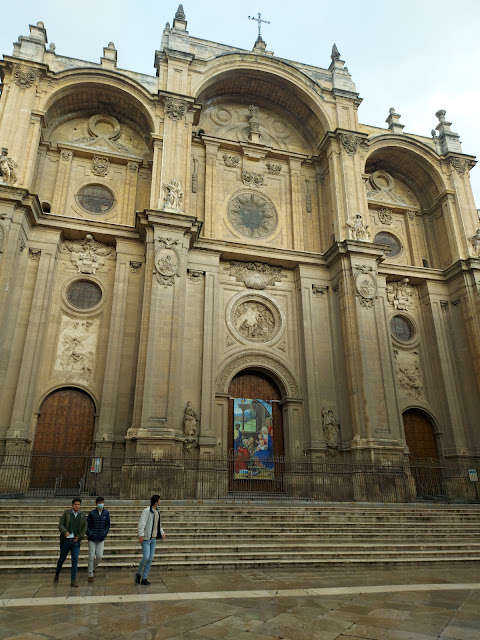 |
| Granada was the capital of the Emirate of Granada, the last major Muslim ruled state on the Iberian Peninsula. Its most famous landmark is the Alhambra |
 |
| On the hill next to the Alhambra is the Generalife, a summer palace. |
 |
| The Nasrids ruled the Emirate of Granada. They built the Generalife in the 13th century. |
 |
| The Spaniards did some remodeling after conquering the Emirate of Granada in 1492. |
 |
| Construction on Alhambra was begun in 1238 by the first Nasrid emir, Muhammad I Ibn al-Ahmar |
 |
| Charles V commissioned this palace in Alhambra. |
 |
| The palace was begun in 1526, but never completed due to the Morisco rebellions in Granada. |
 |
| The Puerta del Vino |
 |
| The Alcazaba is the oldest part of Alhambra. |
 |
| The entrance to the Nasrid Palaces from the Alcazaba |
 |
| From left to right, Generalife, the Nasrid Palaces, and the Palace of Charles V |
 |
| Albaicin is a neighborhood of Granada under the Alhambra famous for its Moorish architecture. |
 |
| The Torre de la Vela |
 |
| The view from the top of the Torre de la Vela |
 |
| The rest of the Alcazaba |
 |
| The Partal Palace, the oldest palace in Alhambra, was built in the early 14th century. |
 |
| When the Caliphate of Cordoba collapsed in 1009 after the Fitna, a group of Berbers called the Zirids established the Taifa of Granada. |
 |
| Under the Zirid kings, the most powerful figure was a Jewish administrator named Samuel ha-Nagid. After his death, the 1066 Granada massacre brought an end to flourishing Jewish culture there. |
 |
| The Nasrid Palaces are the most impressive part of Alhambra. Right now admittance is limited, so make sure you book a ticket in advance. |
 |
| Nice floor |
 |
| Two more Berber groups ruled Granada after the Zirids: the Almoravids and the Almohads. |
 |
| When the Berber kingdoms left al-Andalus and returned to North Africa, the Arab Nasrid dynasty took over Granada. |
 |
| The Almohads left al-Andalus in 1228. Castille captured Cordoba eight years later. |
 |
| The Nasrids were never afraid to play both sides, fighting with and against Castile and the other remaining Muslim Taifas and Emirates on the Iberian Peninsula. |
 |
| Because Granada had to pay heavy tribute to Castile, they specialized in trading high-value goods. |
 |
| Boabdil, Emir Muhammad XII, was the last Muslim ruler of Granada, and on the Iberian Peninsula. |
 |
| After the Reconquista, Granada slowly took on a more Catholic and Castilian air. |
 |
| Napoleon purposely destroyed large portions of Alhambra during the Peninsular War. |
 |
| The Spanish Bourbons tried refurbishing Alhambra (with their coat of arms). |
 |
| The Court of Lions |
 |
| The Nasirids were light-skin toned Arabs. |
 |
| The city of Granada would be worth a trip by itself, even without Alhambra. |
 |
| The Corral del Carbon was a Nasrid caravanserai. |
 |
| The Cathedral of Granada was built over the Nasrid Great Mosque in the 16th century. |
 |
| It was built when Spanish Renaissance style was replacing Gothic style. |
 |
| The Royal Chapel of Granada is built into the side of Granada Cathedral and not to be missed. Isabella and Ferdinand are buried here, along with Juana la Loca. |
 |
| Tres Reyes |
 |
| The Darro river separates Alhambra from the Albayzin neighborhood. |
 |
| Granada has a small archeology museum. |
 |
| A Roman statue |
 |
| An astrolabe from the Nasrid era |
 |
| The museum has a great view. |
 |
| Churros and melted chocolate are a popular snack in Spain. |
 |
| In Granada, if you order a drink, the tapas are free. |
 |
| Artichoke hearts |
 |
| Offal omelet |
 |
| Most tapas places are famous for a type of tapa they make. They are also chains with 3-4 locations close together in the city. |
 |
| Our favorite tapas place was Bar Los Diamantes. |
 |
| For atmosphere stop by Bodegas Castaneda for a glass of Vermouth fresh from the barrel and their house tapa of breadcrumbs, sausage, and cheese. |
 |
| You can never have enough jamon iberico. |
 |
| Not a bad way to spend Christmas! |













No comments:
Post a Comment